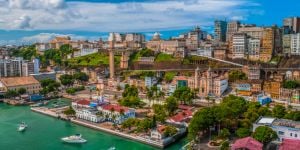Hello Armand,
As a long time resident of São Paulo who uses public transportation on a daily basis going to a number of different destinations each week I can tell you that if you know a few basic tricks it really isn't too terribly bad. Unless you board your bus at one of the local bus terminals you will likely have to stand during the trip since during peak hours most buses are jam packed. I am fortunate enough to live a very short distance from one so I'm ok.
During rush hours both the Metrô (subway) and CPTM (commuter trains) are filled to bursting. Just trying to get on or off the trains can be dangerous because of the crowds so be very careful in the push and shove and keep your hands well away from the doors while they are in motion. I almost got my hand pulled into the space between the door and car one time when I got jostled and almost fell. I escaped with only some minor cuts and scrapes, but one could easily lose a few fingers or hand.
The most important thing to remember is to go out and by a Bilhete Único (bus pass) and always keep it topped up with sufficient credits. This will allow you to use four different buses during a two hour period on weekdays while paying only one R$3,00 fare. When paying cash fares you pay on each bus since there are no transfer priviledges. On Sundays and holidays the period is extended to three hours. The Bilhete Único also permits transfer onto both the Metrô and CPTM with a small additional fare and may also be used as your fare payment for both systems, by paying cash you must remember that tickets purchased for the Metrô and for CPTM cannot be used in the other system's turnstiles so this is another advantage of the pass. Cash fares for both CPTM and Metrô by themselves is RS2.90.
Planning your trip is always very important too and can save you lots of time if you know what you are doing. The most helpful tools for this purpose are both Google Maps and the SPTrans website. For instance from the bairro where I live using CPTM and the Metrô to get to Av. Paulista (Consolação) takes an hour and a half, sometimes more. Yet if I take the 847P-10 Itaim Bibi and transfer on Heitor Penteado to any passing Metrô Vila Mariana I can make the same trip in an hour. So you can see it really pays to get to know how to hunt out the shortcuts.
Whenever possible plan to travel outside of peak hours, you will avoid crowded buses and being stuck in the bumper-to-bumper traffic which makes up part of daily life here in São Paulo by doing so. It is even better still if you are traveling in the opposite direction to the rush hour flow, both buses and trains are almost empty.
Public transportation is a long way from being perfect in this city and people complain a lot, but it is a world better than it was five years ago, it has improved greatly since the creation of new bus corridors and terminals over the past years. Now after many years of delays and disaster Linha 4 - Amarelo is almost fully operational, well at least from Luz to Butantã and integrates with CPTM at Luz and Pinheiros this should also improve things considerably over the next several months.
The singlemost important recommendation I can make for anyone who uses public transportation regularly is be very patient and leave yourself plenty of time to get to your destination. I routinely build an extra half hour into my travel time. By catching that earlier bus then I can sit and relax when unforseen delays happen (and they usually do) without getting stressed out because I have built a safety cushion into my trip. The other advantage is that once I arrive at my destination by doing this I have time for a leisurely cup of coffee before I start a class.













